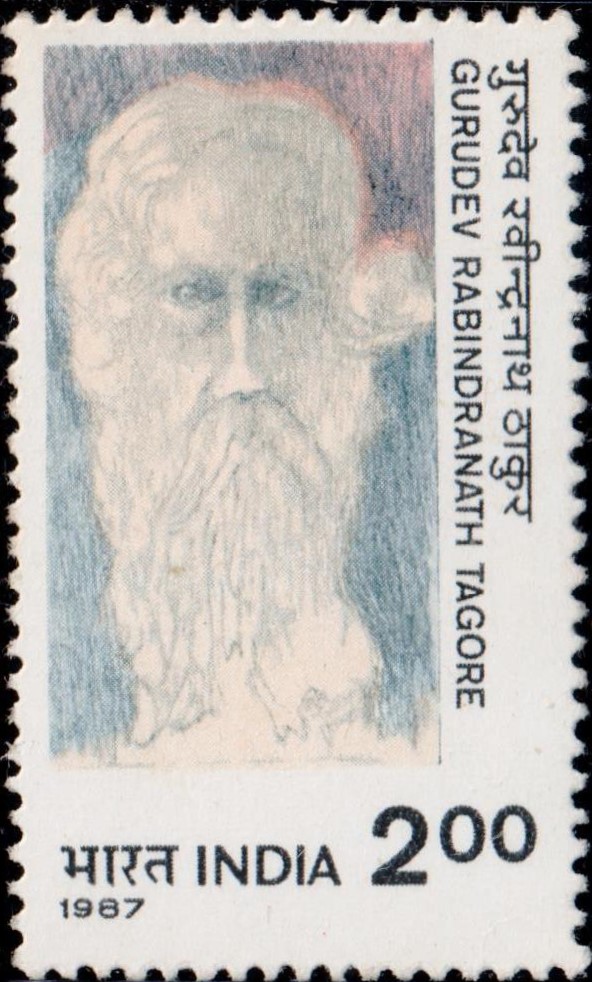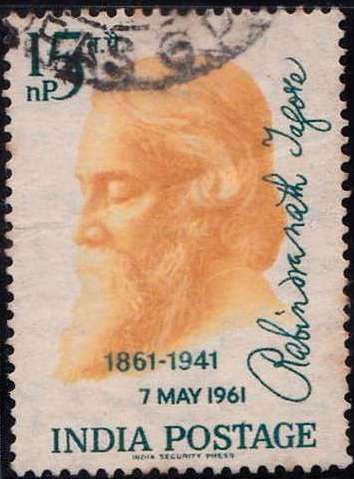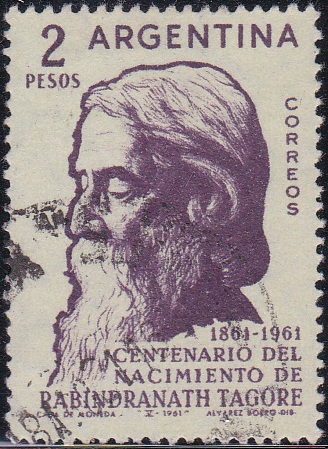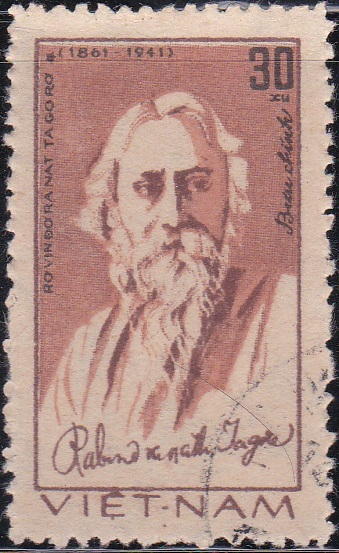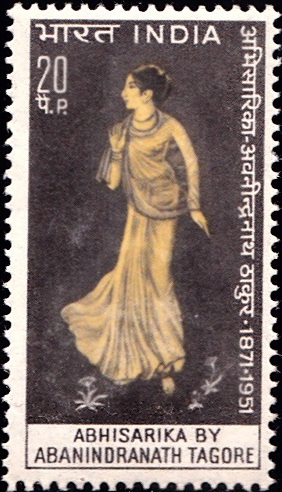
India on Rabindranath Tagore 2011
A Miniature Sheet consisting of 2 nos. of commemorative postage stamps on the 150th Birth Anniversary of Gurudev Rabindra Nath Tagore :
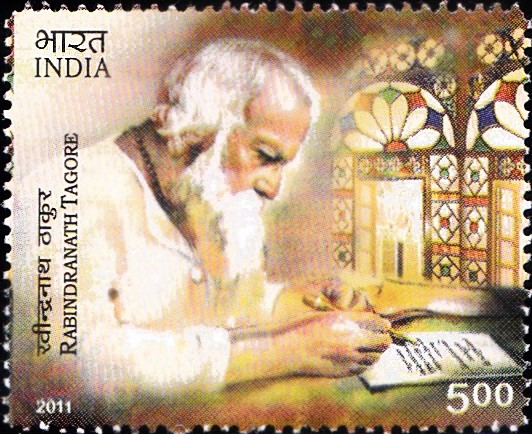
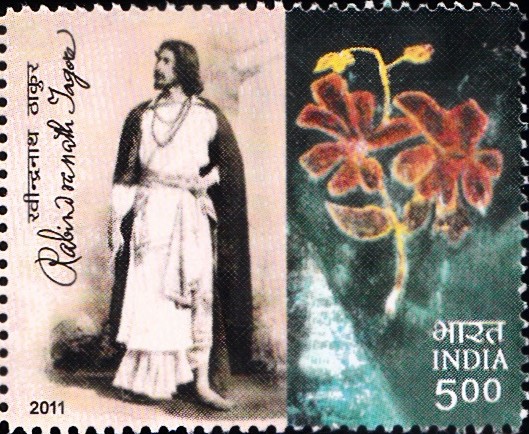

 Issued by India
Issued by India
Issued on May 7, 2011
Issued for : India Post is feeling proud in releasing the set of stamps to commemorate 150 years of Rabindranath Tagore birth anniversary.
Design : The design of the stamps depicts; Tagore‘s writing – background shows Upasana ghar at Santiniketan; Tagore performing in his play ‘Valmiki Pratibha‘ and a painting by him.
FDC : Tagore inset against one of his paintings.
Brochure : Some doodles & scribbles of Tagore.
Credits :
Stamp & FDC : Sankha Samanta
Cancellation : Alka Sharma
Type : Miniature Sheet, Mint Condition
Colour : Multi colour
Denomination : 500 Paise each
Stamps Printed : 0.6 Million each (0.3 million for normal distribution and 0.1 million for e-post office to be sent to Sansad Marg HO, 0.2 million for proponent to be sent to Sansad Marg HO)
Miniature Sheets : 0.2 Million (0.1 million for normal distribution and 0.1 million for e-post office to be sent to Sansad Marg HO)
Printing Process : Wet Offset
Printer : India Security Press, Nashik
Name : Rabīndranātha Thākura
Born on May 7, 1861 at Kolkata, India
Died on Aug 7, 1941 at Kolkata, India
About :
- The fourteenth child of Maharshi Debendranath Tagore and Sarada Devi, Rabindranath Tagore was born on 7 May 1861 at Jorasanko, Kolkata. His creative genius was nothing short of epic-poet, essayist, writer of fiction and drama, musician, performer, educator and builder of institutions. His work has a universality that marks the triumph of humanism and creativity with a social purpose. Dropping out from formal education, he set up two unique school : Patha Bhavan and Siksha Satra and an international University Visva Bharati and Santiniketan.
- He wrote his first drama ‘Prithvirajer Parajey‘ in 1873 but today no copy of this exists. The next year his poem ‘Abhilasha‘ was published in ‘Tattwabodhini Patrika‘ and in 1875 he made his first public appearance to recite his patriotic poem ‘Hindumela Upohar‘. His study of Law at the University College of London remained incomplete as he returned in 1880. His writing of prose, verse, drama and music was prolific. Through the years of marring to Mrinalini Devi, birth of five children and the ups and downs of his personal life, he continued to write and involve himself in the social and political problems of India.
- His first book, ‘Sandhya Sangit‘, was published in 1880 and in 1881 he wrote his first musical drama ‘Valmiki Pratibha‘. He advocated education in the mother tongue, critical of the prevalent system of English education. He started a Swadeshi store in Kolkata and a jute pressing factory in Kushtia to promote indigenous goods and employment for youth. He read a paper ‘Kantharodh‘, reacting to the arrest of Bal Gangadhar Tilak in 1898.
- Moving to Santiniketan with his family, Tagore revived Bankim Chandra Chattopadhyaya‘s monthly journal ‘Bangadarshan‘. The nucleus of Santiniketan was begun in 1901 but the foundation stone was laid in 1918. He advocated a policy of constructive non-cooperation against the British through his articles and essays, but withdrew from the ‘Swadeshi‘ movement disillusioned over the political exploitation of the Hindu-Muslim conflict.
- ‘Gitanjali‘, his magnum opus, was first published in Bengali (1910). A meeting with the British painter, William Rothenstein, led to the publication of ‘Gitanjali‘ in English by the India Society of London, with an introduction by W.B. Yeats. Macmillan, London, also published ‘Gitanjali‘ along with ‘The Gardener‘, ‘Crescent Moon‘ and ‘Chitra‘ and in 1913 Tagore became the first Asian recipient of the Nobel Prize for Literature. Knighted in 1915, he also met Gandhi the same year at Santiniketan. He renounced his Knighthood in protest against the Jallianwala Bagh Massacre in 1930.
- In 1916 he began his journeys to countries in Asia, Europe, South America, Africa and the USA, writing and speaking on nationalism, education and culture and also raising funds for the Visva Bharati University. He was often invited for Lectures at Universities. Doodles on his writings led to this emergence as a painter in 1924. Performing in his plays, holding exhibitions of his paintings, delivering lectures, writing and publishing his works, expanding Santiniketan, leading a protest against the High Detention Camp shooting incident – Tagore‘s life was a multi-coloured fabric in which not a single thread was wasted.
- In 1940 Oxford University conferred a Doctorate on him. His last lecture was read out at his eightieth birthday. He breathed his last on 7th August 1941.
- Text : Based on the material provided by the proponent.



